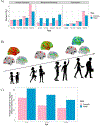The Roles of Physical Activity, Exercise, and Fitness in Promoting Resilience During Adolescence: Effects on Mental Well-Being and Brain Development
- PMID: 33067166
- PMCID: PMC7878276
- DOI: 10.1016/j.bpsc.2020.08.005
The Roles of Physical Activity, Exercise, and Fitness in Promoting Resilience During Adolescence: Effects on Mental Well-Being and Brain Development
Abstract
Adolescence is a critical yet vulnerable period for developing behaviors important for mental well-being. The existing literature suggests that physical activity (PA), exercise, and aerobic fitness promote well-being and reduce risk of mental health problems. In this review, we focus on PA, exercise, and fitness as modifiable resilience factors that may help promote self-regulation via strengthening of top-down control of bottom-up processes in the brain, thereby acting as a buffer against mental health problems during this period of vulnerability. First, we briefly review the link between PA, exercise, and aerobic fitness with mental well-being and reduced mental health problems in adolescence. Then we present how impairments in self-regulation, which involves top-down control to modulate bottom-up processes, are common across a wide range of mental health disorders. Finally, we use the extant neuroimaging literature to highlight how neural systems underlying top-down control continue to develop across adolescence, and propose that PA, exercise, and aerobic fitness may facilitate resilience through strengthening individual brain regions as well as large-scale neural circuits to improve emotional and behavioral regulation. Future neuroimaging studies assessing the effects of PA, exercise, and aerobic fitness at various developmental stages in each sex and studies considering the characteristics (e.g., frequency, intensity, type) and social context of PA and exercise are vital to better understand both macro- and microscale mechanisms by which these behaviors and attributes may facilitate mental health resilience during adolescent development.
Keywords: Emotion; Externalizing symptoms; Internalizing symptoms; Neurodevelopment; Prefrontal cortex; Self-regulation.
Copyright © 2020 Society of Biological Psychiatry. Published by Elsevier Inc. All rights reserved.
Conflict of interest statement
Figures



References
-
- Sawyer SM, Azzopardi PS, Wickremarathne D, Patton GC (2018): The age of adolescence. The Lancet Child & Adolescent Health. 2:223–228. - PubMed
-
- Dahl RE, Suleiman A, Luna B, Choudhury S, Noble K, Lupien SJ, et al. (2017): The Adolescent Brain: A second window to opportunity. UNICEF.
-
- Lenroot RK, Giedd JN (2006): Brain development in children and adolescents: Insights from anatomical magnetic resonance imaging. Neuroscience & Biobehavioral Reviews. 30:718–729. - PubMed
Publication types
MeSH terms
Grants and funding
LinkOut - more resources
Full Text Sources
Other Literature Sources
Medical

